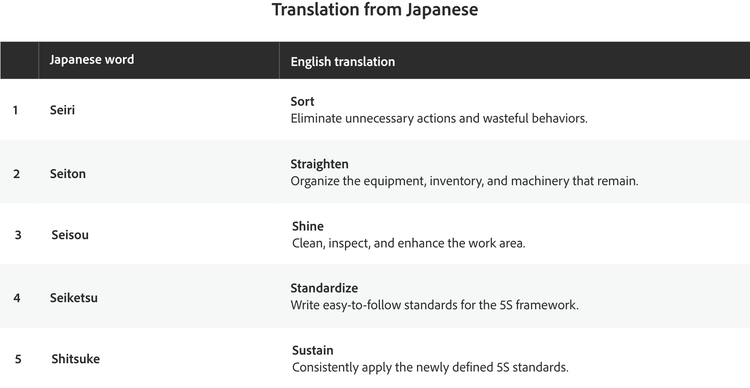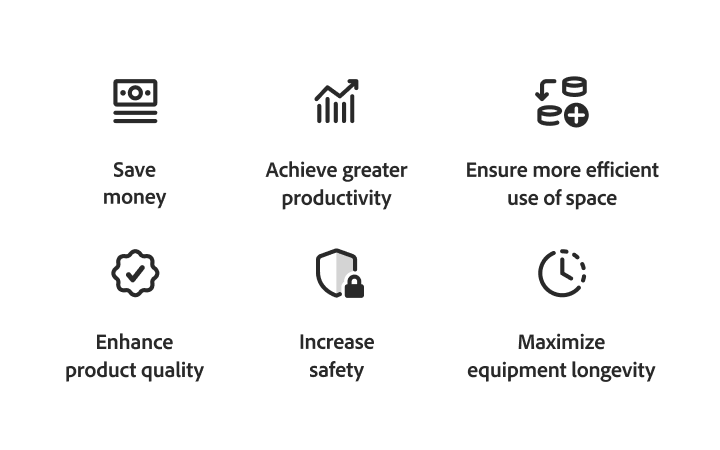Professionals at Toyota developed the 5S methodology as part of the broader Lean manufacturing framework.
The creators of the framework aimed to address multiple business challenges. Specifically, they sought to reduce non-value-adding time, enhance work efficiency, promote safety, and optimize organizational effectiveness.
The methodology is built on these five Japanese words:
-
Seiri (Sort): Eliminate unnecessary actions and wasteful behaviors.
-
Seiton (Straighten): Organize the remaining equipment, inventory, and machinery.
-
Seisou (Shine):Clean, inspect, and enhance the work area.
-
Seiketsu (Standardize): Develop clear and concise standards for the 5S framework.
-
Shitsuke (Sustain): Apply the newly defined 5S standards, consistently.
1. Sort
Seiri or Sort focuses on systematically distinguishing between necessary and unnecessary items within a workspace — and ruthlessly eliminating the latter. The primary goal is to eliminate all forms of clutter, whether obsolete tools, excess inventory, outdated paperwork, or redundant digital files, that create physical and cognitive distractions, hinder efficient workflow, and pose safety hazards.
A critical tool for executing the Sort phase is the red-tagging process. This method provides a structured and visual way to manage the identification and disposition of questionable items. The process involves a team systematically evaluating every item in a designated area, asking a series of critical questions:
- What is the purpose of this item?
- When was this item last used?
- How frequently is it used?
- Who is the primary user of this item?
- Is it essential for this item to be located here?
For items whose value or necessity is uncertain, a red tag is affixed. This tag typically contains information such as the item description, the date it was tagged, the name of the person who tagged it, and the reason for tagging. These red-tagged items are then moved to a centrally located, designated holding area. This structured approach prevents the premature disposal of potentially valuable items while still removing them from the active workspace.
The Sort phase delivers immediate and visible results. It dramatically frees up valuable physical floor space. More importantly, it reduces the cognitive load on employees by eliminating visual clutter and distractions, allowing them to focus more effectively on value-adding tasks.
2. Straighten
Once the workspace has been decluttered, Seiton or Straighten can begin. This phase aims to logically and ergonomically arrange all remaining necessary items to ensure they are easily found, used, and returned.
Straighten relies heavily on visual management tools to make the organizational system intuitive and self-sustaining. Effective implementation moves beyond simple arrangement to engineer a workspace that communicates its operating logic.
Key tools include:
- Shadow boards and tool foam: These tools create a visual home for every hand tool. A shadow board has an outline of each tool painted or affixed to a pegboard, making it immediately obvious where a tool belongs and, more importantly, when it is missing. Tool foam, often used in drawers, consists of two-toned foam layers where the outline of each tool is cut from the top layer. The contrasting bottom color is revealed when a tool is removed, providing a clear visual cue that an item is in use or missing.
- Floor marking and labeling: The use of durable, industrial-grade floor marking tape and clear, standardized labels is fundamental to Straighten. This practice visually designates specific locations for machinery, pallets, mobile equipment (like pallet jacks), trash receptacles, and works-in-progress. It also defines clear pedestrian walkways and traffic lanes, which significantly improve both workflow and safety.
- Ergonomic placement: A core principle of Straighten is organizing items based on their frequency of use. Tools and materials used most frequently should be placed closest to the point of use, within easy reach of the operator. This minimizes wasted motion, such as walking, bending, and reaching, which not only improves efficiency but also reduces the risk of ergonomic injuries and physical strain.
3. Shine
Seiso or Shine involves much more than simple cleaning. It aims to thoroughly clean the work area, equipment, and tools — and to integrate this cleaning activity with regular inspections and proactive preventive maintenance. A critical aspect of Shine is that it is the responsibility of every employee within their workspace, not a task delegated solely to a cleaning crew. This practice fosters a powerful sense of ownership and pride in the work environment. When employees are responsible for the condition of their equipment and area, they become more attuned to their normal operating state.
The true power of the Shine pillar lies in its function as a form of inspection. A clean machine and a spotless work area make abnormalities instantly visible. An oil leak on a freshly painted floor, a small crack in a machine guard, unusual vibrations, or signs of excessive wear become immediately apparent during the cleaning process. This allows for proactive maintenance to be performed before a minor issue escalates into a major failure. This proactive approach prevents costly unplanned downtime, extends the operational lifespan of equipment, and enhances overall safety and reliability.
4. Standardize
Seiketsu (standardize) is the crucial step that prevents the workplace from regressing to its former chaotic state. It aims to create consistent, documented, and visually intuitive procedures that ensure the principles of Sort, Straighten, and Shine are maintained as the new operational standard.
Standardization is achieved by embedding the new practices into the daily work routine through clear and accessible tools:
- Checklists and Job Cycle Charts: These documents formalize the responsibilities associated with the 5S methodology. A checklist might detail the specific cleaning and inspection tasks to be performed at a workstation at the end of each shift. A job cycle chart can assign specific 5S duties (e.g., "check red tag area," "restock supplies") to specific roles on a daily or weekly schedule, ensuring clear accountability.
- Visual Cues and Controls: Standardization relies heavily on making the correct procedures the easiest ones to follow. This is achieved through consistent visual cues, such as standardized color-coding for different types of materials or zones, clear signage indicating workflows, and labels that provide operating or cleaning instructions directly at the point of use.
- Before-and-After Photos: Displaying visual documentation of the transformation achieved during the initial 5S blitz serves as a powerful and constant reminder of the established standard. These photos help reinforce the new expectations and demonstrate the tangible benefits of the program, motivating teams to maintain the gains.
5. Sustain
Shitsuke or Sustain, is the most challenging and critical phase of the 5S methodology. It aims to transform the 5S principles from a set of externally imposed rules into a long-term, self-perpetuating habit. Without a comprehensive sustain phase, even the most successful 5S implementations will inevitably fade over time as old habits creep back in.
Sustaining 5S is an active, ongoing process driven by several key factors:
- Visible leadership commitment: This is the single most critical factor for long-term success. Managers and executives must be visibly and consistently engaged — participating in gemba walks (visits to the actual workplace), personally reviewing audit results, allocating necessary resources, and celebrating successes.
- Ongoing training and communication: 5S is not a one-time training event — it requires ongoing training and communication. New employees must be onboarded into the 5S culture, and existing employees need regular reinforcement. Continuous communication through team meetings, newsletters, performance reviews, and visual management boards keeps the principles top-of-mind and allows for the sharing of best practices across the organization.
- Audits and performance measurement: Regular, scheduled 5S audits serve as a mechanism for ensuring accountability and driving continuous improvement. These audits should utilize a standardized checklist or scorecard to provide objective, data-driven feedback on compliance levels across various areas. The results can identify areas that are excelling and those that may need additional coaching or resources — creating a crucial feedback loop that fuels the Kaizen cycle.
6. Safety
Some organizations believe that properly implementing Lean manufacturing procedures based on the 5S framework promotes optimized workplace safety. Others consider safety so vital that they choose to address it as a separate step.
For instance, implementing Sort, Straighten, and Shine can have a measurable impact on workplace safety. These aspects of the 5S methodology help organize a workplace environment for your staff. Since Shine also includes a tool maintenance component, this step can help prevent equipment-related workplace accidents.
However, some safety practices aren’t addressed explicitly in 5S. For examples, the framework provides no clear direction about the need for proper safety signage.
If your organization considers signage a component of a “clean” work environment, this will likely be addressed during the Straighten or Shine stage. However, if your team doesn’t share this view, signage may be overlooked as they progress through the 5S process.




